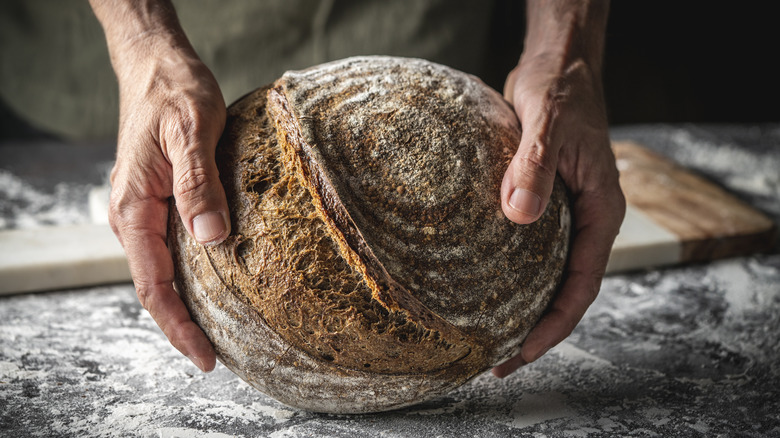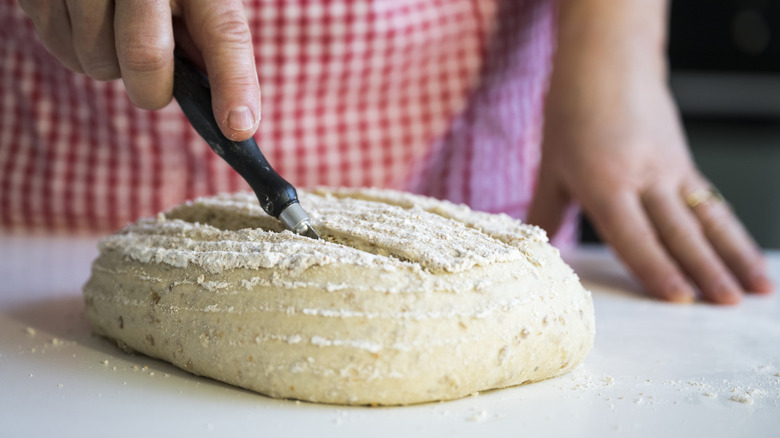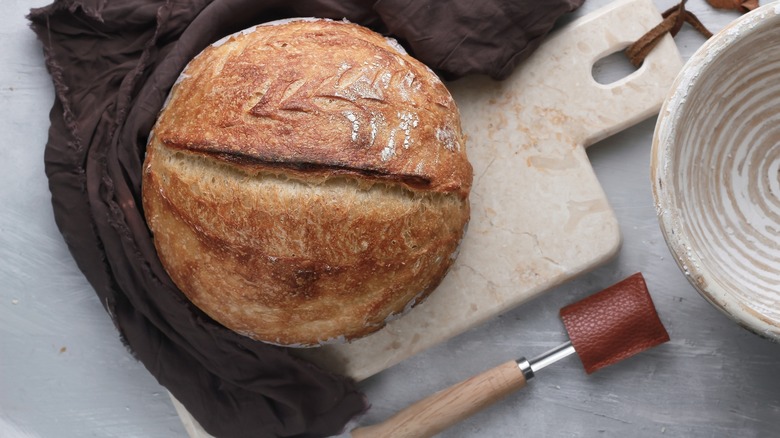How To Score Sourdough Bread For A Beautiful Rise Every Time
If you have ever stopped to stare at an especially artfully arranged display of bread in a bakery, you may have noticed the elaborate markings on some of the crusts. From a single slash to geometric gashes, looping curves, and floral patterns, these designs atop loaves of all shapes and sizes are the result of a technique called scoring, which involves using a sharp tool to make incisions in raw bread dough. Scoring is a way for a baker to express themselves artistically, but it also serves an important function: It helps bread rise.
If you're new to baking, the easiest scoring pattern for your first loaf of bread is a very simple and familiar one: the hashtag. All you need to do is slice two parallel lines across the loaf in one direction, then two more at a perpendicular angle through the center. Make sure the cuts are about a quarter of an inch deep all the way along the lines. Keep in mind that the fewer the lines you make, the deeper the cut should be. If you're scoring several small lines across the dough, they should be shallow — just breaking the skin of the dough.
Why it's important to score bread
If you have gotten your sourdough starter to a place where it's happily bubbling and growing every day, you've already done the hardest part of preparing to make a quintessential sourdough farm loaf from scratch. By the time your dough is ready to go in the oven, you're so close to enjoying that first warm bite of fluffy, fresh bread, but don't let yourself be tempted to skip scoring. This is the final step of the baking process and it plays a critical role in how your loaf will turn out. Taking that extra few seconds to slash the surface of your dough creates a vent where steam can escape as the bread bakes.
Sourdough bread is generally made with just a couple of key ingredients: flour, water, and a scoop of sourdough starter. When mixed together and allowed to rest for a few hours — or a few days, in some cases — the dough undergoes a process of fermentation, and air is captured in its glutinous structure, resulting in the iconic, holey crumb of the final baked product. Later, when placed in the heat of an oven, the water in the dough begins to evaporate. This can rupture the surface of the loaf, causing jagged seams or giving it a misshapen look. The act of scoring helps direct the movement of the steam toward specific vents so that the bread rises to its greatest height and maintains a neat appearance.
Using and caring for your bread baking tools
To score your homemade bread, you'll need a well-honed cutting device. While you can use a kitchen knife or a razor blade, if you plan to continue baking bread, you may want to consider investing in a lame. This baker's tool — which is pronounced "lahm" — is characterized by a very thin, sharp edge that is designed expressly for the purpose of scoring bread. It cuts cleanly across the surface of the dough without sticking and disrupting the design.
After using a lame to score bread, be sure to carefully clean the blade with a wet cloth to remove any dough, then use a towel to dry it so that it does not become dull or rusty. Do not put your lame in the dishwasher where the heat and humidity can cause damage. When you're all done baking, it's also important to find a safe place to store the lame in your kitchen; this is both to protect the blade from getting chipped and to protect yourself and others from getting hurt. While you may not want a one-trick pony cluttering your kitchen, the tool is small and allows for more dexterity than a razor when slicing your loaf.



